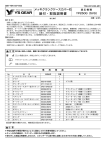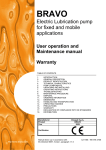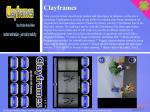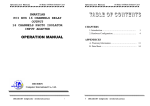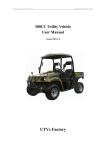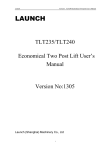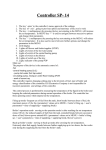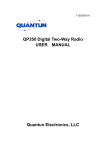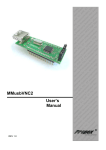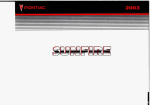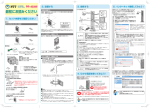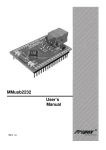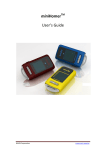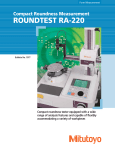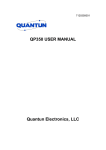Download Owners Manual PDF - Johnny Pag Motor Company
Transcript
O W N E R S MAN UAL Johnny Pag Motor Company This manual should be considered a permanent part of the motorcycle and should remain with the motorcycle when resold or otherwise transferred to a new owner or operator. The manual contains important safety information and instructions which should be carefully before operating the motorcycle. foreword Thank you for choosing a JOHNNY PAG. We at JOHNNY PAG Motor Company have designed, tested, and produced this motorcycle using the most modern technology available. Motorcycling is one of the most exhilarating sports and to insure your riding enjoyment, you should become thoroughly familiar with the information presented in this Owner’s manual before riding the motorcycle. The proper care and maintenance that your motorcycle requires are outlined in this manual. By following these instructions explicitly, you will insure a long, trouble-free operating life for your motorcycle. Your JOHNNY PAG dealer has experienced technicians that are trained to provide your machine with the best possible service with the right tools and equipment. All information, illustrations photographs, and specifications contained in this manual are based on the latest product information available at the time of publications. Due to improvements or other changes, there may be some discrepancies in this manual. JOHNNY PAG Motor Company reserves the right to make changes at any time. Please note that your model may have different standard features than shown in this manual . © COPYRIGHT JOHNNY PAG IMPORTANT BREAK-IN INFORMATION FOR YOUR MOTORCYCLE The first 1000miles (1600km) are the most important in the life of your motorcycle. Proper break-in operation during this time will help ensure maximum life and performance from your new motorcycle. JOHNNY PAG parts are manufactured of high quality materials, and manufactured parts are finished with close tolerances. Proper breakin operation allows the machined surfaces to polish each other and mate smoothly. Motorcycle reliability and performance depend on special care and restraint exercise during the break-in period. It is especially important that you avoid operating the engine in a manner which could expose the engine parts to excessive heat. Please refer to recommendations. the BREAK-IN section for specific break-in WARNING/CAUTION/NOTE Please read this manual and follow its instructions carefully. To emphasize special information, please find the following warnings. ! WARNING ! CAUTION The personal safety of the rider may be involved. Disregarding this information could result in injury. These instructions point out special service procedures or precautions that must be followed to avoid damaging the machine. NOTE This provides special information to make maintenance easier or important instructions clearer. ! WARNING Noise Control System (muffler assembly) TAMPERING WITH NOISE CONTROL SYSTEM PROHIBITED Owners are warned that the law may prohibit: (a)The removal or rendering inoperative by any person other than for the purpose of maintenance, repair or replacement, of any device or element of design incorporated into any new vehicle for the purpose of noise control to its any sale or delivery to the ultimate purchaser or while it is in use; and (b)The use of the vehicle after such device or element of design has been removed or rendered inoperative by any person. MAINTENANCE: The exhaust system of this motorcycle requires no periodic maintenance. The engine should be adjusted to the manufacture‟s specifications and the spark plug should be kept in good condition. Running the engine with incorrectly operating spark plug or misadjusted carburetor may cause permanent damage to the catalyst and to the noise control system. CONSUMER INFORMATION SAFE RIDING RECOMMENDATION FOR MOTORCYCLE RIDERS Motorcycle riding is great fun and an exciting sport. Motorcycle riding also requires that some extra precautions be taken to ensure the safety of the rider and passenger. These precautions are: ! WARNING Before first use of the Ventura, read this owner‟s manual carefully to become familiar with the Ventura „s features, and safety and maintenance requirements. Review all instructions, requirements and warnings. Before the rider‟s first use of the Ventura, make sure that he/she is familiar with the location and operation of all controls, and has been instructed in the proper operation of the motorcycle. For first use of the Ventura, find a level, open area for the rider to use to become familiar with the operation of controls and the operating and handling characteristics of the Ventura. ! WARNING Before each use, perform inspections. Specific items to check are listed in the INSPECTION BEFORE RIDING section of the owner‟s manual. Make sure the rider wears a helmet, eye protection, and protective clothing (gloves, leather or heavy cloth pants, long sleeved shirt or jacket, boots). Do not permit anyone to operate the Ventura under the influence of alcohol or other drugs. Observe periodic maintenance requirements at your authorized JOHNNY PAG dealer. Caution the riders and others near the Ventura not to get too close to or touch any moving parts of any heated areas such as the engine and exhaust system. Do not make any modifications to the Ventura. Modifications may make the motorcycle unsafe or illegal in your state. ! WARNING Keep both hands on the handgrips at all times when riding. Removing your hands from the handgrips reduces your ability to control the motorcycle, and could result in an accident. ! WARNING Do not run the engine indoors or where there is little or no ventilation. Exhaust gases contain carbon monoxide, a potentially lethal gas that is colorless and odorless Never leave the motorcycle running while unattended, even for a short time. ! WARNING The Ventura is equipped with the side stand ignition interlock system. If This side stand ignition interlock system will prevent the motorcycle from being started with side stand down. ! WARNING Riding on bad weather days, especially wet ones, requires extra caution. Braking distances double on a rainy day. Stay off the painted surface marks, manhole covers and greasy appearing areas as they can be especially slippery. Use extreme caution at railways crossings and on metal gratings and bridges. Whenever you have a doubt about road condition, slow down! ! NOTE The head lamp and tail lamp always come on when starting engine. ! WARNING Ride within the boundaries of your own skill at all times. Knowing these limits and staying within them will help you to avoid accidents. ! WARNING We suggest that you practice riding your motorcycle in a non-traffic situation until you are thoroughly familiar with your machine and its controls. Remember, practice makes perfect. ! WARNING Loose clothing can be uncomfortable and unsafe in terms of riding your motorcycle. Choose good quality motorcycle riding apparel when riding your motorcycle. ! WARNING Motorcycle safety equipment starts with a quality safety helmet. One of the most serious injuries that can happen is a head injury. ALWAYS wear a properly approved helmet. You should also wear a suitable eye protection. ! WARNING Always open the throttle gradually to prevent front wheel lifting. Failure to observe this precaution may result in loss of control and an accident. ACCESSORY INSTALLATION AND PRECATION SAFETY TIPS There are a great variety of accessories available to JOHNNY PAG owners. JOHNNY PAG cannot have direct control over the quality or suitability of accessories you may wish to purchase except genuine Johnny Pag parts. The addition of unsuitable accessories can lead to unsafe operating conditions. It is not possible for JOHNNY PAG to test each accessory on the market or combinations of all the available accessories, however, your dealer can assist you in selecting quality accessories and installing them correctly. Use extreme caution when selecting and installing the accessories for your JOHNNY PAG. We have developed some general guidelines which will aid you when deciding whether, and how to equip your motorcycle. 1. In case that additional weight or aerodynamic affecting accessories are installed, they should be mounted as low as possible, as close to the motorcycle and as near the center of gravity as is feasible. The mounting brackets and other attachment hardware should be carefully checked to ensure that it provides for a rigid, non-movable mount. Weak mounts can allow the shifting of the weight and create a dangerous, unstable condition. 2. Inspect for proper ground clearance and bank angle. An improperly mounted load could critically reduce these two safety factors. Also determine that the “load” does not interfere with the operation of the suspension, steering or other controls operations. 3. Accessories fitted to the handlebars or the front fork area can create serious stability problems. This extra weight will cause the motorcycle to be less responsive to your steering control. The weight may also cause oscillations in the front end and lead to instability problems. Accessories added to the machine should be as light as possible and kept to a minimum. 4. The motorcycle may be affected by a lifting condition or by instability in cross winds or when being passed or passing large vehicles. Improperly mounted or poorly designed accessories can result in an unsafe riding condition, therefore caution should be used when selecting and installing all accessories. 5. Certain accessories displace the rider from his or her normal riding position. This limits the freedom of movement of the rider and may limit his or her control ability. 6. Additional electrical accessories may damage the existing electrical system. Severe overloads may damage the wiring harness or create a dangerous situation due to the loss of electrical power during the operation of the motorcycle. SERIAL NUMBER LOCATION The frame and/or engine serial numbers are used to register the motorcycle. They are also to assist your dealer in terms of ordering parts or referring to special service information. The frame serial number is stamped on the steering head tube. The engine serial number is stamped on the left bottom of the crankcase assembly. Please write down the numbers in the box provided below for your future reference. Frame Number: Engine Number: FUEL, ENGINE OIL AND COOLANT RECOMMENDATION FUEL Use unleaded gasoline with an octane rating of 91 or higher. Unleaded gasoline can extend spark plug life and exhaust components life. ! CAUTION Spilling gasoline can damage the painted surfaces. Be careful not to spill any fuel when filling the fuel tank. Wipe spilled gasoline up immediately. ! WARNING When refueling, always shut the engine off and turn the ignition key to the “OFF” position. Never refuel near the flames, sparks or heat sources. Do not overfill the fuel tank. Stop adding fuel when the fuel level reaches the bottom of the filler neck. ENGINE OIL 1. ENGINE OIL SPECIFICATIONS Classification System Grade API Over SL SAE 10W/40 Remarks Using premium quality, four stroke motor oil will increase the service life of your motorcycle. COOLANT Use an anti-freeze compatible with aluminum radiator mixed with distilled water only at the ratio 50:50 ! WARNING Engine coolant is harmful or fatal if swallowed or inhaled. Do not drink anti-freeze or coolant solution. If swallowed, do not induce vomiting. Immediately contact a poison control center or a physician. Avoid inhaling mist or hot vapors; if inhaled, remove to fresh air. If coolant gets in eyes, flush eyes with water and seek medical attention. Wash thoroughly after handing. Solution can be poisonous to animals. Keep out of the reach of children and animals. ! CAUTION Spilled engine coolant can damage painted surfaces. Do not spill any fluid when filling the radiator. Wipe spilled engine coolant up immediately. *ANTI-FREEZE The coolant performs as rust inhibitor and water pump lubricant as well as anti-freeze. Therefore the coolant should be used at all times even though the atmospheric temperature in your area does not go down to freezing point. Required amount of water/coolant Solution capacity (total) 50% Water Coolant 1.0 ℓ 0.5 ℓ 0.5 ℓ NOTE This 50% mixture will protect the cooling system from freezing at temperatures above -31*C (-23.8 OF). If the motorcycle is to be exposed to temperature from -31*C (-23.8 OF) to -40*C (-40 OF), this mixing ratio should be increased up to 55% coolant. If the motorcycle is to be exposed to temperatures from -41*C (-41.8 OF) to -55*C (-67 OF), this mixing ratio should not exceed 60% coolant. 1. Clutch Lever 2. Left handle switch 3. Instrument panel 4. Front brake fluid reservoir 5. Right Handle switch 6. Front brake lever 7. Throttle grip 8. Fuel tank cap 1. Air Filter 2. Fuel Pump 3. Left spark plug 4. Radiator Fan 5. Radiator 6. Shift Lever 7. Foot Peg 8. Radiator Reservoir 9. Kickstand 10. Engine Number Location 11. Battery 12. Axel Block / Chain Adjuster 1. Right Spark Plug 2. Ignition Coils 3. Seat 4. Exhaust 5. Dipstick 6. Oil Screen (inside cover) 7. Water Pump 8. Foot Peg 9. Rear Brake Lever 10.Master Cylinder 11.Neck Lock CONTROLS IGNITION Ventura has the ignition switch on the right side. The ignition switch has two positions: *” OFF ” POSITION All electrical circuits are cut off. The engine will not start. The key can be removed. *” ON “ POSITION The ignition circuit is completed and the engine can now start. The key cannot be removed from the ignition switch in this position. ! WARNING Turning the ignition switch to the “ OFF “ position while the motorcycle is moving can be hazardous. STEERING Lock The Ventura has a steering lock below the steering head tube. To lock the steering: 1. Turn the handlebar all the way to the left. 2. Insert the ignition key into the steering lock, and turn clockwise to lock, counterclockwise to unlock. 3. The ignition key can be removed in both positions. ! WARNING Moving the motorcycle while the steering is locked can be hazardous. You could lose your balance and fall, or you could drop the motorcycle. Stop the motorcycle and place it on the side stand before locking the steering. Never attempt to move the motorcycle when the steering is locked. The Ventura comes equipped with a pair of identical ignition keys. Keep the spare key in a safe place. 1- TURN SIGNAL INDICATOR LAMP When the turn signals are being operated either to the right or to the left, the appropriate indicator will flash at the same time. 2- HIGH BEAM INDICATOR LAMP The high beam indicator lamp will come on when the head lamp high beam is turned on. 3- NEUTRAL INDICATOR LAMP The neutral indicator lamp will come on when the transmission is in neutral. The lamp will go out when you shift into any gear other than neutral. 4- EFI Warning light The EFI Warning light will come on when there is an issue with the Fuel Injection system. This may indicate that the motorcycle engine is hot. ! CAUTION Running the engine with high engine coolant temperature can cause serious engine damage. If the Red EFI light comes on, stop the engine to let it cool. SPEEDOMETER The speedometer indicates the road speed in miles per hour or kilometers. ODOMETER / TRIP METER The display in it has two functions, odometer and a trip meter. The odometer registers the total distance that the motorcycle has been ridden. The trip meter odometer is resettable. ! WARNING Operating the display while riding can be hazardous. Removing a hand from the handlebars can reduce your ability to control the motorcycle. Always keep both hands on the handlebars while riding. FUEL METER The fuel gauge indicates the remaining fuel amount in the fuel tank. The “F” (Full) mark indicates the fuel tank is full. The “E” (Empty) mark indicates the tank is empty or nearly so. ! CAUTION For checking the fuel meter, hold the motorcycle vertically with the ignition switches “ON”. LEFT HANDLE 1.CLUTCH LEVER The clutch lever is used for disengaging the drive to the rear wheel when starting the engine or shifting the transmission gear. Squeezing the lever disengages the clutch. 2.“PASS” SWITCH Press the “PASS” switch to momentarily engage the head lamp high beam when passing another vehicle for behind. With the ignition switch in the “ON” position, push the “PASS” switch to operate the head lamp high beam. 3.HIGH/LOW BEAM “ 3A” : The head lamp high beam come on “3b” : the head lamp low beam come on 4.TURN SIGNAL SWITCH Using when left, right turn or change direction. Position : Flash the left turn signal lamp Position : Flash the right turn signal lamp. ! CAUTION Always use the turn signals when you intend to change lanes or make a turn. Always be sure to turn the turn signal switch to the “OFF” position after completing the turn or lane change. 5.HORN SWITCH Press the switch to operate horn. RIGHT HANDLE 1. ENGINE STOP SWITCH 1A- Off Position : The ignition circuit is off. The engine cannot start or run. 1B- On Position : The ignition circuit is on and the engine can run. ! WARNING Do not place the engine stop switch into the “Off” position while driving the motorcycle. 2. FRONT BRAKE LEVER The front brake is applied by squeezing the brake lever gently toward the throttle grip. The brake lamp will come on when the lever is squeezed. ! WARNING Apply the brake lightly and with great care on slippery surfaces to avoid skidding. 3. THROTTLE GRIP Engine speed is controlled by position of the throttle grip. Turn it toward you to increase engine speed. Turn it away from you to decrease the engine speed. ! WARNING Avoid turning the throttle grip during braking. 4. RUNNING LIGHT SWITCH Use this switch to toggle the headlight on or off. 5. STARTER SWITCH Use this switch to operate the starting motor. ! CAUTION Do not engage the starting motor for more than five seconds at a time as it may overheat the wiring harness and starting motor. If the engine does not start after several attempts, check the fuel supply and ignition system. ! WARNING The Ventura is equipped with the side stand ignition interlock system. This side stand ignition interlock system prevents the motorcycle from being started with side stand down. REAR BRAKE Depressing the rear brake pedal will apply the rear brake. The brake lamp will be illuminated when the rear brake is operated. ! WARNING Apply the brake lightly and with great care on slippery surfaces to avoid skidding. GEARSHIFT LEVER The Ventura has a 5-speed transmission which operates as shown. To shift properly, pull the clutch lever and close the throttle, then operate the gearshift lever. Whenever a gear is selected, the gearshift lever will return to its normal position ready to select the next gear. Lift the gearshift lever to upshift and depress the lever to downshift. Neutral is located between 1st and 2nd gear. It is not possible to upshift or downshift more than one gear at a time. When shifting from 1st to 2nd gear or 2nd gear to 1st, neutral will be automatically skipped. ! CAUTION When the transmission is in neutral the green indicator lamp on the instrument panel will be lit. However, even though the light is illuminated, slowly release the clutch lever to determine whether the transmission is positively in neutral. SIDE STAND The Ventura is equipped with the side stand ignition interlock system. The side stand ignition interlock system prevents the motorcycle from being started with side stand down. SUPPLY OF GASOLINE ENGINE OIL AND COOLANT GASOLINE To open the fuel tank cap, insert the ignition key into the lock and turn it clockwise. With the key inserted, lift the cap up with the key. To close the fuel tank cap, push the cap down firmly with the key in the cap lock. ! WARNING Do not overfill the fuel tank. Stop adding fuel when the fuel level reaches the bottom of the filler neck. If you fill the tank beyond this level, fuel may overflow when it expands due to engine heat or heating by the sun. ! WARNING Gasoline is extremely flammable and toxic. Always observe the following precautions when refueling your Ventura. Refuel in a well-ventilated area. Make sure the engine is off and avoid spilling fuel on a hot engine. Do not smoke, and make sure there are no open flames or sparks in the area. Avoid prolonged contact with skin and breathing of gasoline vapors. Keep children and pets away during refueling. ENGINE OIL Long engine life depends much on the selection of quality oil and the periodic changing of the oil. Daily oil level checks and periodic changes are two of the most important maintenances to be performed. *ENGINE OIL LEVEL CHECK Follow the procedure below to inspect the engine oil level. 1. Start the engine and run it for a few minutes. 2. Stop the engine and wait three minutes. 3. Hold the motorcycle vertically and inspect the engine oil level via the dipstick. ! CAUTION Never operate the motorcycle if the engine oil level is below the “Lower line mark” on the engine oil dipstick. Never fill the engine oil above the “Upper line mark”. Engine oil level is suitable about 1mm under the “Upper line mark” of the dipstick. ENGINE OIL CHANGE AND OIL SCREEN CLEANING The procedure is as follows. ENGINE OIL CAPACITY Completely 1.6 ℓ drained ! CAUTION In case of the engine oil over fill, the engine performance will be affected. Be careful if the engine oil is hot. ! CAUTION More frequent servicing may be performed on motorcycles that are used under severe conditions. Inspect; 1 Quantity of Engine oil, 2 Pollution degree of Engine oil before riding the motorcycle and then supplement and replace at any time to prevent damage of the engine. 1. Place the motorcycle on the jack. 2. Place a drain pan under the engine. 3. Remove the engine oil filler cap 4. Drain the oil by removing the drain plug located on the bottom of the engine. ! CAUTION Confirm and clean the oil strainer during first replacement of the engine oil Refer to the maintenance schedule for additional requirements 5. 6. 7. 8. Remove case bolts Remove strainer from oil pump Clean strainer with soapy water – rinse thoroughly and reinstall Reinstall side cover using a new gasket – check that the old gasket has been completely removed from the side cover and engine case. Any leftover pieces of gasket will create an oil leak. ! WARNING Engine oil and exhaust pipes can be hot enough to burn you. Wait until the oil drain plug and exhaust pipes have cooled before any maintenance is performed. ! WARNING New and used oil can be hazardous. Children and pets may be harmed by swallowing new or used engine oil. Continuous contact with used engine oil has been found to cause skin cancer in laboratory animals. Brief contact with used oil can irritate skin. Keep new and used oil away from children and pets Wear a long-sleeve shirt and water proof gloves. Wash with soap if oil contacts your skin. 9. Replace the drain plug and tighten it securely. Pour fresh oil through the filler hole. Approximately 1.6 ℓ of oil will be required. ! CAUTION Approximately 1.6 ℓ (54.1oz) of oil is required when changing oil. 10. Operate the engine a few seconds by idling speed. Inspect the oil leakage at the oil drain plug. 11. Confirm the oil level with the oil lever dipstick after waiting 3 minutes after stopping the engine. The oil level is located between the “Lower line” and the “Upper line” on the dipstick. COOLANT *COOLANT LEVEL The coolant should be kept between the “F” (FULL) and “L” (LOW) level lines in the reservoir tank at all times. Inspect the level every time before riding while the motorcycle is in the vertical position. ! WARNING Engine coolant is harmful or fatal if swallowed or inhaled. Do not drink anti-freeze or coolant solution. If swallowed, do not induce vomiting. Immediately contact a poison control center or a physician. Avoid inhaling mist or hot vapors; if inhaled, remove to fresh air. If coolant gets eyes, flush eyes with water and seek medical attention. Wash thoroughly after handling. Solution can be poisonous to animals. Keep out of reach of children and animals. !NOTE Adding only water will dilute the engine coolant and reduce its effectiveness. Add 50 : 50 mixture of engine coolant and distilled water. *CHANGING THE COOLANT Change the coolant as recommended in the service schedule. ! WARNING You can be injured by scalding fluid or steam if you open the radiator cap when the engine is hot. RIDING TIPS STARTING THE ENGINE 1. 2. 3. 4. 5. Inspect before riding the motorcycle. The transmission is in neutral. The ignition switch is in the “ON” position. Moving the side stand to the upper position. Pull the clutch lever. ! WARNING The Ventura is equipped with the side stand ignition interlock system. This side stand ignition interlock system prevents the motorcycle from being started with side stand down. ! CAUTION Do not engage the starting motor for more than five seconds at a time as it may overheat the wiring harness and starting motor. If the engine does not start after several attempts, check the fuel supply and ignition system. STARTING OFF ! WARNING Riding this motorcycle at excessive speed increases your chances of losing control of the motorcycle. This may result in an accident. Always ride within the limits of your skills, your motorcycle, and the riding conditions. ! WARNING Removing your hands from the handlebars or feet from the footrests during operation can be hazardous. If you remove even one hand or foot from the motorcycle, you can reduce your ability to control the motorcycle. Always keep both hands on the handlebars and both feet on the footrests of your motorcycle during operation. ! WARNING Sudden side winds, which can occur when being passed by large vehicle, at tunnel exits or in hilly areas, can upset your control. Reduce your speed and be alert to side winds. USING THE TRANSMISSION The transmission is provided to keep the engine operating smoothly in its normal operating speed range. The gear ratios have been carefully chosen to meet the characteristics of the engine. The rider should always select the most suitable gear for the prevailing conditions. ! WARNING Downshifting when engine speed is too high can: Cause the rear wheel to skid and lose traction due to increases engine braking, resulting in an accident or; Force the engine to over-rev in the lower gear, resulting in engine damage. Reduce speed before downshifting. RIDING ON HILLS STOPPING AND Climbing steep hills, the motorcycle may begin to slow down and show lack of power. At this point you should shift to a lower gear so that the engine will again be operating in its normal power range. Shift gear rapidly to prevent the motorcycle from losing momentum. When riding down a steep hill, the engine may be used for braking by shifting to a lower gear. Be careful, however, not to allow the engine to over-rev. ! WARNING Inexperienced riders tend to underutilize the front brake. This can cause excessive stopping distance and lead to a collision. Using only the front or rear brake can cause skidding and loss of control. ! WARNING Hard braking while turning may cause wheel skid and loss of control. Brake before you being to turn. ! WARNING Hard braking on wet, loose, rough, or other slippery surfaces can cause wheel skid and loss of control. Brake lightly and carefully on slippery or irregular surfaces. ! WARNING Following another vehicle too closely can lead to a collision. As vehicle speeds increase, stopping distance increases progressively. Be sure you have a safe stopping distance between you and the vehicle in front of you. ! WARNING A hot muffler can burn you. The muffler will be hot enough to burn you for some time after stopping the engine. Park the motorcycle where pedestrians or children are not likely to touch the muffler. 1. 2. 3. 4. 5. Park the motorcycle on a firm, flat surface where it will not fall over. Turn the ignition switch to the “OFF” position and remove ignition key. Put the kickstand in the down position. Turn the handlebar all the way to the left. Remove the ignition key. BREAK-IN This section explains how important proper break-in is to achieve maximum life and performance from your new JOHNNY PAG. The following guidelines explain proper break-in procedures. MAXIMUM THROTTLE OPENING RECOMMENDATIONS The table below shows the maximum throttle opening recommendations during the break-in period. Initial 800km (500miles) Up to 1600km (1000miles) Less than ½ throttle Less than ¾ throttle AVOID CONSTANT LOW SPEED Operating the engine at constant low speed (light load) can cause parts to glaze and not set in. allow the engine to accelerate freely through the gears, without exceeding the recommended maximum limits. Do not, however, use full throttle for the first 1,600km (1000miles) VARY THE ENGINE SPEED The engine speed should be varied and not held at a constant speed. This allows the parts to be “loaded” with pressure and then unloaded, allowing the parts to cool. This aids the mating process of the parts. It is essential that some stress be placed in the engine components during break-in to ensure this mating process. Do not apply excessive load on the engine. BREAKING IN THE NEW TIRES New tired need proper break-in to assure maximum performance, just as the engine does. Wear in the tread surface by gradually increasing your concerning lean angles over the first 160km (100miles) before attempting maximum performance. Avoid hard acceleration, hard cornering, and hard braking for the first 160km (100miles). ! WARNING Failure to perform break-in of the tires could cause tire slip and loss of control. Use extra care when riding on new tires. Perform proper break-in of the tire as described in this section and avoid hard acceleration, hard cornering, and hard braking for the first 160km (100miles). ALLOW THE ENGINE OIL TO CIRCULATE BEFORE RIDING Allow sufficient idling time after warm or cold engine start up before applying load or revving the engine. This allows time for the lubricating oil to reach all critical engine components. OBSERVE YOUR FIRST, AND ALL ADDITIONAL SERVICES The 1,000km (600miles) service is the most important service your motorcycle will receive. During break-in procedures, all of the engine components will have worn in and all of the other parts will haves set in. The 1,000km (600miles) service ensures all adjustments will be restored, all fasteners will be tightened, and the dirty engine oil will be replaced, and the oil screen will be cleaned. Timely performance of the 1,000km (600miles) service will ensure optimum service life and performance from the engine. ! CAUTION Service should be performed before 1000km (600miles) on motorcycles that are used under severe conditions. ! CAUTION The 1,000km (600miles) service should be performed as outlined in the INSPECTION AND MAINTENANCE section of this Owner‟s manual. Pay particular attention to the [CAUTION] AND [WARNINGS] IN THAT SECTION. INSPECTION BEFORE RIDING Before riding the motorcycle, be sure to check the following items. Inspect every day once before riding motorcycle. WHAT TO CHECK Steering Throttle Clutch Brakes Suspension Fuel Drive Chain Tires Engine Oil Cooling System Lighting Horn Engine Stop Switch Side Stand / Ignition Interlock Switch CHECK FOR: Smoothness No restriction of movement No play or looseness Correct play in the throttle cable Smooth operation and positive return of the throttle grip to the closed position Correct lever play Smooth and progressive action Fluid level in the reservoir to be above “LOWER” line Correct pedal and lever play No “sponginess” No fluid leakage Brake pads not to be worn down to the limit line Smooth movement Enough fuel for the planned distance of operation Correct tension or slack No excessive wear or damage Correct pressure Adequate tread depth No cracks or cuts Correct level and pollution degree of engine oil Proper coolant level No coolant leakage Operation of all lights and indicators Correct function Correct function Proper operation PERIODIC MAINTENANCE The following chart indicates the intervals between periodic services in kilometers/miles. 1,000Km/600Mi 6,000Km/3,700Mi 12,000Km/7,400Mi 3,000Km/1,800Mi At the end of each interval, be sure to inspect, check, lubricate and service as instructed. If your motorcycle is used under high stress conditions such as continuous full throttle operation, or is operated in a dusty climate, certain services should be performed more often to ensure reliability of the machine as explained in the maintenance section. Your JOHNNY PAG dealer can provide you with further guidelines. Steering components, suspensions require very special and careful servicing. For maximum safety we suggest that you have these items inspected and serviced by your authorized JOHNNY PAG dealer or a qualified service mechanic. *LUBRICATION POINTS Proper lubrication is important for smooth and long life of each working part of your motorcycle and also for safe riding. It is a good practice to lubricate the motorcycle after a long rough ride or after it gets wet in the rain or washing it. ! WARNING Improper maintenance or failure to perform recommended maintenance increases the chance of an accident or motorcycle damage. ! CAUTION Using poor quality replacement parts can cause your motorcycle to wear more quickly and may shorten its useful life. Use only genuine JOHNNY PAG replacement parts or their equivalent. !NOTE = Ask your JOHNNY PAG dealer or qualified mechanic to do the maintenance items marked. INSPECTION AND MAINTENANCE ENGINE OIL Check if there is leakage from crankcase. GASOLINE Check for leakage from fuel tank, fuel pump, fuel petcock, hose, and throttle body. FUEL HOSE Inspect the fuel hose for damage and fuel leakage. If any defect are found the fuel hose must be replaced. Replace the fuel hose every 4 years. COOLANT Check if there is leakage from the radiator, coolant hose. RADIATOR Check if there is damage to the radiator. EXHAUST PIPE Inspect the exhaust pipe and muffler joint for loosening. FRONT FORK Inspect for leaks at the top of the fork and the bottom of the fork REAR SHOCK Inspect the rear shock absorber for oil leakage and spring condition. BATTERY *INSPECTION OF BATTERY SOLUTION LEVEL This motorcycle uses a MF (maintenance Free) type battery. It is not necessary to inspect or supplement battery fluid. The battery is located under the seat. However, have your dealer check the charging condition of battery periodically. ! CAUTION Do not remove the cover from a maintenance free type battery. *CLEAN OF BATTERY TERMINAL Clean the battery terminal when it is dusty or rusted. 1. Set the ignition switch “OFF” position. 2. Disassemble the seat, disassemble the ( - ) Negative battery wire then the ( + ) Positive battery wire. Remove the battery. 3. Clean the terminal. If there is white dust, clean it with warm water. 4. Assemble the battery wires and grease the terminal lightly before reinstallation. ! CAUTION Keep the battery away from fires. When disassembling the battery wires, take off (-) terminal first with the ignition switch “OFF” position. When reassembling, install (+) terminal first. Fasten certainly the battery wires. Incorrect installation of the battery will reverse the terminal position resulting in possible electrical system damage due to incorrect battery lead connection. Never charge a battery while still in the machine as damage may result to the battery or regulator / rectifier. AIR CLEANER If the air cleaner element has become clogged with dust, intake resistance will increase and with a result in a decrease in power output and an increase in fuel consumption. If riding under severe conditions the air cleaner element must be cleaned or replaced more frequently than recommended in the maintenance schedule. Check and clean the air cleaner element periodically according to the following procedure. ! CAUTION If the air cleaner element is dirty, the result will be decreased engine power output, a decline in combustion efficiency, and sooty smoke (black smoke) coming from the exhaust. 1. The air cleaner is located under the seat. Remove the seat and then the left side cover. 2. Uninstall the air cleaner assembly 3. Remove the cover of the air cleaner assembly. 4. Pull out the air cleaner element. 5. Clean the air cleaner element with soapy water a. Carefully examine the air cleaner element for tears during cleaning. b. Allow the air cleaner to completely dry before reinstallation. Installing a wet air filter can severely damage the engine. c. Be careful not to allow water to remain inside the air cleaner element after cleaning. ! CAUTION Before and during the cleaning operation, inspect the element for tears. A torn element must be replaced. Be sure to reinstall the element snugly and correctly, so no incoming air will bypass it. Remember, rapid wear of piston rings and cylinder bore is often caused by a defective or poorly fitted element. ! CAUTION When the assembly of air cleaner element is not completely done, dusts can go inside and damage severely engine. Be careful not to allow water to remain in the element after washing. ! CAUTION More frequently servicing may be performed on motorcycles that are used under severe conditions, also clean the air cleaner element when replacing the oil to prevent damage of the engine. SPARK PLUG Readjust the spark plug gap to 0.6 ~ 0.7mm by using a spark plug gap thickness gauge. ! CAUTION Do not over torque or cross thread the spark plug or the aluminum threads of the cylinder head will be damaged. Do not allow contaminants to enter the engine through the spark plug holes when the plug is removed. The standard spark plug for this motorcycle has been carefully selected to meet the vast majority of all operational ranges. The selection of an improper spark plug can lead to severe engine damage. THROTTLE CABLE ADJUSTMENT To adjust the cable play: 1. Loosen the lock nut 1. 2. Turn the adjuster 2 so that the throttle cable has 0.5-1.0mm (0.02-0.04 in) play. 3. Tighten the lock nut 1 holding the adjuster 2. ! WARNING Inadequate throttle cable play can cause engine speed to rise suddenly when you turn the throttle grip. This can lead to loss of rider control. ! CAUTION After completing throttle cable adjustment, check that throttle grip movement does not raise the engine idle speed and that the throttle grip returns smoothly and automatically. CLUTCH ADJUSTMENT At each maintenance interval, adjust the clutch cable play by means of clutch cable adjuster. The cable play should 2mm (0.08in) as measured at the clutch lever holder before the clutch begins to disengage. 1. The lock nut 2. The clutch lever adjuster If you find the play of the clutch incorrect, adjust it in the following way: *CLUTCH CABLE ADJUSTMENT Loosen the lock nut Adjust the clutch lever adjuster so the play in the lever is 2mm Screw the lock nut clockwise fully, finishing adjustment After end of adjustment, tighten the lock nut and cover with the rubber boot If further adjustment is necessary, please see your authorized Johnny Pag Dealership Clutch cable play 2mm (0.08 in) DRIVE CHAIN The drive chain may require more frequent adjustment than is listed in the periodic maintenance schedule depending upon your riding conditions. Check the chain every 1,000km. ! WARNING Riding with the chain in poor or improperly adjusted condition can lead to an accident Inspect, adjust, and maintain the chain properly before each ride, according to this section. *INSPECTING THE DRIVE CHAIN When inspecting the Chain, look for the following: Common types of chain wear and damage Improper adjustment If you find something wrong with the chain condition or adjustment, correct the problem if you know how. If necessary, consult your authorized JOHNNY PAG dealer. Damage to the chain means that the sprockets may also be damaged. Inspect the sprockets for the following: Excessively worn teeth Broken or damaged teeth Loose mounting nuts If you find any of these problems with your sprocket, consult your JOHNNY PAG dealer. ! CAUTION The two sprockets should be inspected for wear when a new chain is installed and replace them if necessary *CHAIN SLACK ADJUSTMENT Adjust the chain slack to the proper specification. The chain may require more frequent adjustments than periodic maintenance schedule depending upon your riding conditions. Adjust the chain in the following way. 1. Place the motorcycle on the jack or block. 2. 3. 4. Loosen the axle bolt. 5. For alignment of the rear sprocket and the engine sprocket, there are Loosen the lock nut. Adjust the slack in the drive chain by turning the adjusting nuts clockwise or counterclockwise. reference marks on the left and right axel blocks. Aligning and adjusting the slack in the drive chain to specification, retighten the lock nut and axle bolt securely and perform a final inspection. DRIVE CHAIN SLACK (4.5kg(9.9lb) of Force) When the rear tire is 4.5-5.5 mm touching the ground (0.18-0.22in) When the rear tire is 5.0-6.0mm not touching the (0.20-0.24in) ground ! CAUTION The chain should be inspected every time before riding. Excessive chain slack could cause the chain to come off the sprockets and result in accident or serious engine damage. ! WARNING Be careful not to touch the muffler when it is hot: a hot muffler can burn you. BRAKES The Johnny Pag Ventura utilizes front and rear disk brakes. The proper operation the brake systems are vital to safe riding. Be sure to perform the brake inspection requirements as schedules. The brakes should be inspected at periodic inspection by your authorized JOHNNY PAG dealer. *BRAKE FLUID Be sure to check the brake fluid level in the master cylinder. If the level is found to be lower than the lower mark holding the motorcycle upright, replenish with the proper brake fluid that meets JOHNNY PAG‟s requirements. As the brake pads wear, the fluid level will drop to compensate for the new position of brake pads. Replenish the master cylinder as per the periodic maintenance schedule. [Front Brake] [Rear Brake] ! WARNING Brake fluid may be harmful if swallowed or if it comes in contact with skin or eyes. Contact your doctor immediately if brake fluid is swallowed and induce vomiting. If brake fluid gets into the eyes or in contact with the skin, flush thoroughly with plenty of water. ! CAUTION This motorcycle uses glycol-based brake fluid. Do not use or mix different types of brake fluid, otherwise serious damage will result in the brake system. Use DOT3 or DOT4 brake fluid for front, and DOT3 brake fluid for rear Do not spill any brake fluid on painted or plastic surfaces as it will damage the surface severely. Never use any brake fluid that has been stored in a used or unsealed container. Never reuse brake fluid left over from the last servicing and stored for long period as it absorbs moisture from the air. *BRAKE PADS Inspect the front brake pads by noting whether or not the friction pads are worn down to the grooved limit line. If a pad is worn to the grooved limit line it must be replaced with a new one by your authorized JOHNNY PAG dealer or qualified service mechanic. Inspect the following points of the brake system. 1. Brake fluid leakage of the front and rear master cylinders. 2. Leak or damage of the brake hoses. 3. Operating of the brake lever and pedal. 4. Wear of the front and rear brake pads. ! WARNING Riding with worn brake pads will reduce braking performance and will increase your chance of having an accident. Inspect brake pad wear before each use. Ask your JOHNNY PAG dealer or qualified mechanic to replace brake pads if any pad is worn to the limit. *BRAKE DISK INSPECTION Check the brake disk for damage or cracks. *FRONT BRAKE FLUID SUPPLY 1. Place the motorcycle on a level surface and hold the motorcycle up straight (not on the side stand), and keep the handlebars straight. 2. Clean the brake fluid reservoir around not to allow dust to get inside of it. 3. Loosen the screws and open the cap. 4. Replenish with brake fluid to the upper line. ! CAUTION Do not spill any brake fluid on painted or plastic surfaces as it will damage the surface severely. !NOTE The recommended brake fluid DOT3 or DOT4 5. Reinstall the cap. *REAR BRAKE FLUID SUPPLY 1. Place the motorcycle on a level surface and hold the motorcycle up straight (not on the side stand), and keep the handlebars straight. 2. Clean the brake fluid reservoir around not to allow dust to get inside of it. 3. Loosen the screws and open the cap. 4. Replenish with brake fluid to the upper line. !NOTE The recommended brake fluid : DOT3 5. Reinstall the cap. TIRE Inspect the tire pressure and the tire thread depth periodically for your safety and to extend the life of your tires. ! WARNING Failure to follow these warnings may result in an accident or death due to tire failure. The tires on your motorcycle form the crucial link between your motorcycle and the road. Following these instructions: Check tire condition and pressure, and adjust pressure before each ride. Avoid overloading your motorcycle. Replace a tire when worn, or if you discover damage such as cuts or cracks. Always use the size and type of tires specified in this owner‟s manual. *TIRE PRESSURE Insufficient air pressure in the tires not only hastens tire wear but also seriously affects the stability of the motorcycle. Under-inflated tires make smooth cornering difficult and over-inflated tires decrease the amount of tire in contact with the ground which can lead to skids and loss of control. Be sure that the tire pressure is within the specified limits at all times. Tire pressure should only be adjusted when the tire is cold. If you see the problem with the tire, adjust the pressure with the pressure gauge. TIRE PRESSURE (COLD INFLATION) FRONT REAR NORMAL RIDING SOLO RIDING 280 KPA 40.0 PSI 280 KPA 40.0 PSI DUAL RIDING 280 KPA 40.0 PSI 280 KPA 40.0 PSI ! CAUTION If there are some problem with the tire pressure or cracks and cuts, it will decrease the riding stability and lead to flat tire. *CRACKS AND CUTS *TIRE TREAD CONDITION Check if 1. There are visible cracks and cuts. 2. There are pebbles stuck. Operating the motorcycle with an excessively worn tire will decease riding stability and can lead to loss of control. ! CAUTION The standard tire on Ventura is 90/90-21 for front and 140/70 - 18 for rear. It is highly recommended to use the standard tire supplied by JOHNNY PAG. CLEANING PROCEDURE A thorough cleaning of your motorcycle is a necessary part of maintenance and will help keep your motorcycle looking and performing at its best. Proper cleaning can also extend the life of your motorcycle. It is important to clean and inspect your motorcycle after every ride if it is used in mud, brush, grass, water, salt water, or very dusty conditions. The build-up of mud, grass, etc, especially on the engine and exhaust system, can reduce engine cooling, conceal damage, or increase wear of certain parts. It is important to remove all debris during cleaning. ! CAUTION High pressure washers can damage your motorcycle. High pressure washers such as those found at coin-operated washes YOUR haveMOTORCYCLE enough pressure to damage the parts of your *WASHING motorcycle. It may cause rust, corrosion and increase wear. Do not use high pressure washers to clean your motorcycle. With some care, your motorcycle can be washed in a similar manner to washing an automobile. !NOTE Avoid spraying or allowing water to flow over the following places: Spark plug Fuel tank cap Carburetor / EFI system Use a garden hose at low pressure to remove the majority of dirt or other debris. Wash your motorcycle by hand with a mild soap or detergent and water. Try to thoroughly remove all dirt and debris without excessive water pressure. Cloth rags, washing mitts or cleaning brushes can be used. be careful with brushes as they may scratch plastic or painted surfaces. Rinse the motorcycle thoroughly with clean water. Dry all areas using a chamois or soft absorbent cloth. ! WARNING Operating motorcycles with wet brakes can be hazardous. Wet brakes may not provide as much stopping power as dry brakes. This could lead to an accident. Test your brakes after washing motorcycle, riding at slow speed. If necessary, apply brakes several times to let friction dry out the pads. Follow the procedures in the “INSPECTION BEFORE RIDING” section to check your motorcycle for any problems that may have risen during your last ride. SPECIFICATIONS DIMENSIONS AND DRY MASS Overall length Overall width Overall height Wheelbase Ground clearance Mass 2,280mm (89.76in) 790mm (31.10 in) 1,140mm (44.88in) 1,660mm (65.35in) 180mm (7.09in) 151kg (332lb) ENGINE Type Number of cylinder Bore Stroke Piston displacement Starter system Four-stroke, DOHC, liquid-cooled 2 cylinder 62 mm (2.44in) 53mm (2.09in) 320cm3 (320cc) Electric starter TRANSMISSION Clutch Reduction ratio Drive belt Transmission Wet multi-plate type 3.632 Chain 1st: 2.846 2nd: 1.778 3rd: 1.333 4th: 1.083 5th: 0.913 CHASSIS Front suspension Rear suspension Caster Trail Steering angle Front tire size Rear tire size Front brake Rear brake Telescopic type Swingarm type 35 degrees 160mm (6.3in) 35degrees (right & left) 90/90-21 M/C 54H 140/70-18 M/C 67H Double disk disk Ignition type Ignition timing Spark plug Battery Fuse Head lamp License plate lamp Turn signal lamp Brake / tail lamp “igniter” type 10degrees B.T.D.C at 1,500rpm CR7HSA 12V 9Ah Main: 20A, Head lamp: 15A HI: 12V – 35W x 1 LO: 12V – 35W x 1 12V – 5W x 1 12V – 10W x 4 LED type Fuel tank Engine oil 8L (2.11gal) 1.6L (overhaul) (54.1oz) ELECTRICAL CAPACITIES Prepared by JOHNNY PAG MOTOR COMPANY EDITION 1.3
































































